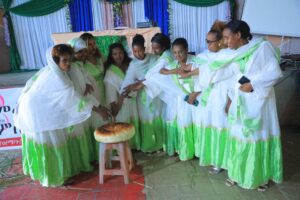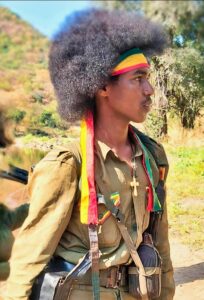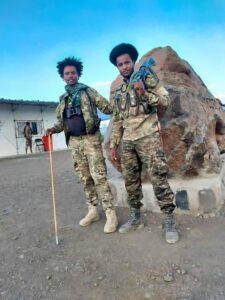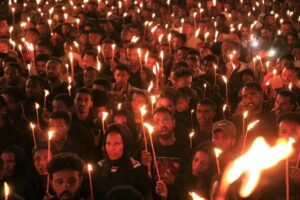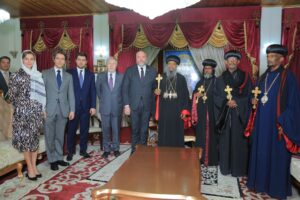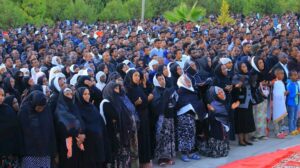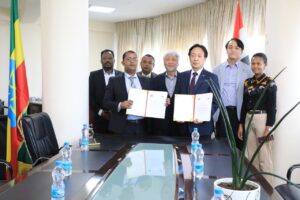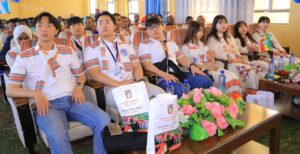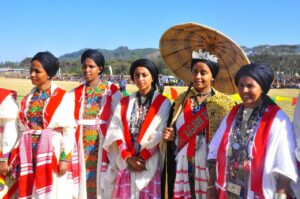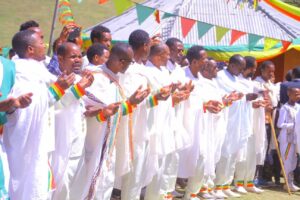Ethiopia › Forums › Ludicrous World › The Qemant minority ethnic group suffer from marginalisation
-
AuthorPosts
-
12th October 2021 at 12:20 am #2237
The Qemant have long complained of marginalisation, struggling even for recognition – in 2007, they were completely omitted from Ethiopia’s census, and today there are no confirmed population figures for the Qemant, who are believed to number many more than the 172,000 last counted in 1994.
‘Finish us off’: Ethiopia’s Qemant say targeted in armed campaign
Zecharias Zelalem
 Amare says he had two options.
Amare says he had two options.“It was either leave home or be killed,” he told Al Jazeera from the safety of a United Nations-run refugee camp in the Basinga village in Sudan’s Gadarif state bordering Ethiopia.
The 20-year-old student, a member of Ethiopia’s Qemant minority ethnic group, fled to the camp to escape what he says was a raid by Ethiopian soldiers on Shinfa, a town in Ethiopia’s Amhara region some 10km (six miles) from the Sudanese border, on June 13.
“They shot at anyone who moved, including the elderly. I’m lucky to be alive,” he said in a phone interview from the camp. “They want to cleanse the Amhara region of the Qemant,” he added. “They’re trying to finish us off.”
Amare is among a growing number of Qemant to level such accusations against Ethiopian troops and allied militias affiliated with the country’s Amhara regional government.
Government officials maintain that civilians are not being targeted by their offensive in Amhara, which they say is linked to the country’s 11-month war that initially pitted forces loyal to the TPLF (Tigray People’s Liberation Front) – the governing party of nearby Tigray region – against the national armies of Ethiopia and neighbouring Eritrea. The fighting in Tigray has killed thousands, displaced millions and has led to a humanitarian crisis that has left hundreds of thousands facing famine-like conditions. In June, Tigrayan forces launched a counterattack that saw them retake much of their region and expand fighting into the neighbouring Amhara and Afar regions.

But in the fog of the war, military operations and mob violence in disputed territories in the northwest of the Amhara region have also led to the displacement of thousands of ethnic Qemant civilians from their homes.
The Qemant live in the Amhara region and are physically and linguistically indistinguishable from the ethnic Amhara, Ethiopia’s second-largest ethnic group who account for nearly a quarter of Ethiopia’s 112 million people.
The Qemant have long complained of marginalisation, struggling even for recognition – in 2007, they were completely omitted from Ethiopia’s census, and today there are no confirmed population figures for the Qemant, who are believed to number many more than the 172,000 last counted in 1994. Meanwhile, requests for regional autonomy by Qemant rights groups have had them at odds with the ethnic Amhara with whom they share a region.
At a news conference in April, the former Amhara regional President Agegnehu Teshager, whose term ended this week, alleged that Qemant “extremists” had formed militias allied with the Tigrayans, although he did not present evidence to support his claim.
“We are fighting a war against Qemant extremists who trained in Sudan and are armed by the TPLF,” he said. “They have already fired on our forces.”
Refugees in Sudan told Al Jazeera that a number of Qemant youths have taken up arms in response to constant raids on their communities. Al Jazeera could not independently verify this, and there is little to no data on the formal founding of a Qemant force or its capacity.
Ethiopia’s government maintains that its forces are in the area to search for suspected Qemant rebels and secure the country’s border from possible infiltrators from Sudan.
But satellite imagery analysis, witness accounts and photographic evidence gathered by Al Jazeera point instead to the involvement of the Ethiopian military and allied militias in the destruction of Qemant communities. Residents have also accused Ethiopian troops of watching idly as allied militias carry out often macabre killings against civilians.
“They have dragged people from homes and butchered them in the streets,” said a man who fled to Gondar following a raid on his hometown. Requesting anonymity due to fears for his security, he accused members of a local Amhara militia known as the Fano of killing more than a dozen Qemant civilians in this manner during a murderous rampage that took place in the town of Aykel between September 1 and 2.
“They kill, steal what they want and leave. This has been happening for months,” he said on the phone.

UK-based non-profit research organisation Vigil Monitor, which has been documenting atrocities across Ethiopia since the breakout of war in November of last year, worked in tandem with Al Jazeera and studied satellite imagery provided by Planet Labs, a private satellite operator, of areas identified by at least a dozen displaced people as having been heavily affected by military operations. The imagery revealed widespread destruction of some 557 civilian structures spanning from May 2021 until the present, largely corroborating witness accounts.
“Over 500 structures have been destroyed deliberately in the Shinfa river area across four settlements,” the organisation said in a written assessment of the imagery. “Affected areas with damage observed in satellite imagery have suffered worsening episodes of violence.”
Vigil Monitor added that different settlements suffered varying degrees and means of violence consistent with time periods and accounts given by witnesses.
“It appears that attacks in the Chilga and Shinfa areas began at least in April,” the organisation said. “We’ve noted significant escalations since then including the mobilisation of Amhara regional forces and the Ethiopian army, the employment of artillery and widespread burning of civilian areas.”
Al Jazeera reached out to Ethiopia’s Ministry of Defence and Ministry of Peace for a response to the allegations but did not receive a response by the time of publication.

Qemant activists and rights groups such as Amnesty International have long accused Ethiopian security forces of complicity in attacks against Qemant civilians that predate the current conflict.
“Institutional violence targeting the Qemant isn’t a new phenomenon and we’ve documented abuses that date back to 2015,” said Abeba Teferie, head of a US-based Qemant advocacy organisation, accusing the Ethiopian authorities of carrying out a campaign of “ethnic cleansing”.
Al Jazeera contacted the spokesperson of Ethiopian Prime Minister Abiy Ahmed for a response to the allegations but did not receive a response by the time of publication.
“We are being punished solely because our people oppose being removed from the national census. Recognition and self-rule are constitutional rights.”
‘Exhausted and in poor health’
About 2,000 ethnic Qemant have fled to the camp in Basinga since late July, according to data by the UN’s refugee agency (UNHCR), including 261 who arrived during a four-day period in mid-September. Another 500 have since made the journey, meaning that nearly half of all documented arrivals fled their homes in September alone.
“Many of the Qemant asylum seekers arrive in eastern Sudan exhausted and in poor health having traversed long, difficult and dangerous routes before reaching safety,” said Giulia Raffaelli, a senior external relations officer at UNHCR. “Several tell us that they found themselves caught up in some of the confrontations, or experienced violence prior to their flight.”
Raffaelli said counselling services were being provided for all arrivals.
“Many are in shock and remain affected by their traumatic experience,” said Tariq Abdaselam, a coordinator at the camp, adding that one of the refugees he had welcomed was suffering from a bullet wound.

The latest known incident of violence took place on September 28 and occurred a day after unidentified gunmen attacked a minibus travelling near the Qemant village of Belehwa. A local news outlet blamed that attack on Qemant “terrorists”.
Belehwa was subsequently set ablaze as retaliation by members of a government-allied militia and angry villagers, according to the account of an witness. “The mob beat people and set homes on fire,” the witness told Al Jazeera.
Planet Labs imagery obtained by Vigil Monitor confirmed that an attack on the village of Belehwa was ongoing as of September 28. Satellite imagery captured the billowing smoke clouding the air above homes caught in the inferno.
Both Gizachew Muluneh, the head of the Amhara region’s Communications Bureau, and Ethiopian military spokesman Major General Mohammed Tessema have not responded to texted messages for comment sent to their phones.
In a separate incident, Belayneh, a 35-year-old Qemant native who was reached by phone from an undisclosed location near the border with Sudan, said he was in the town of Gubay on September 4 when Ethiopian soldiers started shelling.
“There was nothing to target but unarmed civilians going about their daily lives,” Belayneh told Al Jazeera. “Soldiers rained artillery on us from the nearby Lemlem mountain. Everybody panicked and began fleeing for their lives. They destroyed homes and people were killed in the streets. Gubay is completely deserted now, with its residents either in Sudan or in the wilderness.”


Mulugeta, another escapee from the violence in Gubay, said he hid in a shed for hours. When he managed to flee into the hills, he described seeing dozens of mutilated bodies as he ran. “The last I heard was that bodies were decomposing in the open because no one was there to bury them.”
Days later, on September 7, an Ethiopian military commander gave a different version of events. Speaking to state media, he said his troops alongside Amhara regional forces and members of the Fano had fought at Gubay among other locations and repelled an attack by armed Qemant infiltrators from Sudan.
“Over 250 enemy fighters were killed, including some who were killed by local farmers while escaping,” Brigadier General Nasir Abadiga was quoted as saying.
Updated satellite imagery showed parts of Gubay appeared to have been completely reduced to rubble. The primary targets of the shelling seem to have been homes capped with metal sheet roofs, commonly found in rural and urban settings across Ethiopia. Researchers at Vigil Monitor tallied a total of 97 destroyed structures at Gubay and more than a dozen more on its outskirts.
“Damage in the town of Gubay is consistent with that caused by artillery shelling,” the organisation said in a written statement delivered to Al Jazeera. “Given that the Amhara regional forces do not tend to operate artillery, this suggests corroboration of witness testimony alleging the engagement of the Ethiopian army.”

Separately, Al Jazeera has also obtained unverified images from displaced refugees in Sudan showing a variety of projectiles photographed in the aftermath of artillery barrages in the region. Spent shell casings and the fins of what appear to be 81 or 82mm (3.1 or 3.1 inch) mortar ammunition rounds were identified in pictures. Residents say that since May, the use of heavy artillery to level neighbourhoods has become commonplace.
“Soldiers used everything to batter the Bihona village in late August,” Tadele, one of the thousands displaced, told Al Jazeera. “I saw them used RPGs, mortars and dishkas to fire at homes,” he said using a term commonly used in Ethiopia to refer to the Russian made DShk anti-aircraft machine gun.
Brigadier General Abadiga continues to oversee the army’s operations in the area, telling state media on September 20 – barely a week prior to the burning of Belehwa village – that his forces remained committed to “destroying terrorists and securing the border”.
Residents complain that Qemant villages continue to be attacked with impunity, often with direct or at least implicit support of security forces.
Displaced survivors unable to make it to Sudan have few options. Many are said to be hiding in the homes of relatives or in the wilderness, many in areas with no communications services.
“I’ve spent the last month hiding in a forest as it isn’t safe to return home,” said Tadele who fled the attack on Bihona in August. “There are probably tens of thousands of us displaced and spread out across the region. Unlike in Sudan, there are no NGOs here for us,” he added.
“We are on our own.”
Ethiopia Autonomous Media
-
AuthorPosts
You must be logged in to reply to this topic.

